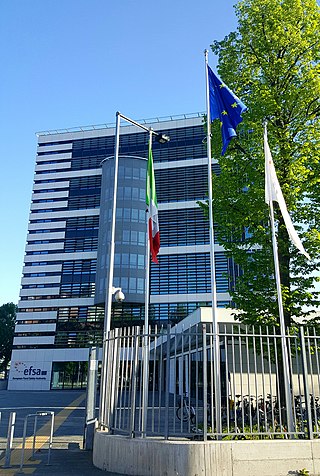Related Research Articles

Methylisothiazolinone, MIT, or MI, is the organic compound with the formula S(CH)2C(O)NCH3. It is a white solid. Isothiazolinones, a class of heterocycles, are used as biocides in numerous personal care products and other industrial applications. MIT and related compounds have attracted much attention for their allergenic properties, e.g. contact dermatitis.

Mechanically separated meat (MSM), mechanically recovered/reclaimed meat (MRM), or mechanically deboned meat (MDM) is a paste-like meat product produced by forcing pureed or ground beef, pork, mutton, turkey or chicken, under high pressure through a sieve or similar device to separate the bone from the edible meat tissue. It is sometimes called white slime as an analog to meat-additive pink slime and to meat extracted by advanced meat recovery systems, both of which are different processes. The process entails pureeing or grinding the carcass left after the manual removal of meat from the bones and then forcing the slurry through a sieve under pressure. This puree includes bone, bone marrow, skin, nerves, blood vessels, and the scraps of meat remaining on the bones.

The European Medicines Agency (EMA) is an agency of the European Union (EU) in charge of the evaluation and supervision of pharmaceutical products. Prior to 2004, it was known as the European Agency for the Evaluation of Medicinal Products or European Medicines Evaluation Agency (EMEA).
The Committee on the Environment, Public Health and Food Safety (ENVI) is a committee of the European Parliament. It has 81 full members and is currently chaired by Pascal Canfin.

The European Food Safety Authority (EFSA) is the agency of the European Union (EU) that provides independent scientific advice and communicates on existing and emerging risks associated with the food chain. EFSA was established in February 2002, is based in Parma, Italy, and for 2021 it has a budget of €118.6 million, and a total staff of 542.
The Consumers, Health, Agriculture and Food Executive Agency (Chafea) was an executive agency of the European Union, set up by the European Commission to manage four programmes on its behalf, in the domains of health, consumer protection, food safety, and the promotion of European agricultural products. From April 2021 on, these programmes were reassigned to other agencies, most notably the newly created Health and Digital Executive Agency (HaDEA).
A food safety agency or food administration or Food Safety Authority is a government agency responsible for ensuring the safety, quality, and proper labeling of food products within a country or region. These agencies play a crucial role in protecting public health by establishing and enforcing regulations and standards to ensure that food produced, imported, processed, distributed, and sold is safe for consumption.

The European Directorate for the Quality of Medicines & HealthCare (EDQM) is a Directorate of the Council of Europe that traces its origins and statutes to the Convention on the Elaboration of a European Pharmacopoeia.

Isothiazolinone (sometimes isothiazolone) is an organic compound with the formula (CH)2SN(H)CO. A white solid, it is structurally related to isothiazole. Isothiazolone itself is of limited interest, but several of its derivatives are widely used preservatives and antimicrobials.
The Scientific Committee on Emerging and Newly Identified Health Risks (SCENIHR) is one of the independent scientific committees managed by the Directorate-General for Health and Consumer Protection of the European Commission, which provide scientific advice to the Commission on issues related to consumer products.
The Scientific Committee on Health and Environmental Risks (SCHER) is one of the independent scientific committees managed by the Directorate-General for Health and Consumer Protection of the European Commission, which provide scientific advice to the Commission on issues related to consumer products.
The following outline is provided as an overview of and topical guide to clinical research:
The Directorate-General for Health and Food Safety, until 2014 known as the Directorate-General for Health and Consumers, is a directorate-general of the European Commission. The DG is responsible for the monitoring and implementation of European Union policies and laws on health and food safety. It is headed by European Commissioner for Health and Food Safety Stella Kyriakides and Director-General Sandra Gallina.

The Non-GMO Project is a 501(c)(3) non-profit organization focusing on genetically modified organisms. The organization began as an initiative of independent natural foods retailers in the U.S. and Canada, with the stated aim to label products produced in compliance with their Non-GMO Project Standard, which aims to prevent genetically modified foodstuffs from being present in retail food products. The organization is headquartered in Bellingham, Washington. The Non-GMO label began use in 2012 with Numi Organic Tea products.
The Scientific Committee on Food (SCF), established in 1974, was the main committee providing the European Commission with scientific advice on food safety. Its responsibilities have been transferred to the European Food Safety Authority (EFSA).
Genetic engineering in the European Union has varying degrees of regulation.

Galaxolide is a synthetic musk with a clean sweet musky floral woody odor used in fragrances. It is one of the musk components that perfume and cologne manufacturers use to add a musk odor to their products. Galaxolide was first synthesized in 1965, and used in the late 1960s in some fabric softeners and detergents. High concentrations were also incorporated in fine fragrances.

The Norwegian Scientific Committee for Food and Environment (VKM),, conducts open, independent, scientific risk assessments regarding safe food, food production and the environment upon request of the Norwegian Food Safety Authority and the Norwegian Environment Agency. VKM also carries out risk assessments on animal health, plant health, animal welfare and cosmetics for the Norwegian Food Safety Authority, and on microbiological products and alien organisms and trade in endangered species (CITES) upon request from the Norwegian Environment Agency. In addition, the Committee makes environmental risk assessments of genetically modified organisms for the Norwegian Environment Agency. The assessments are used as a basis for knowledge of the various ministries in Norway. The assessments also provide a basis for knowledge which the Norwegian Food Safety Authority uses to provide advice and determine regulations. The committee may raise matters on its own initiative. Risk assessments are made on an independent basis in accordance with internationally established methods. The scientific committee itself is to carry out risk assessments on their own initiative. The risk assessments are used by the Norwegian Food Safety Authority and the Norwegian Environment Agency when giving advice to Norwegian ministries, and when the Norwegian Food Safety Authority is developing new laws and regulations.

The German Federal Institute for Risk Assessment, abbreviated BfR, is a body under public law of the German federal government with full legal capacity. The institute comes under the portfolio of the Federal Ministry of Food and Agriculture and has the task of providing scientific advice to the federal government on issues relating to food safety, product safety, chemical safety, contaminants in the food chain, animal protection and consumer health protection. Further technical supervision is performed by the Federal Ministry for the Environment, Nature Conservation, Building and Nuclear Safety and the Federal Ministry of Transport.

A pesticide, also called Plant Protection Product (PPP), which is a term used in regulatory documents, consists of several different components. The active ingredient in a pesticide is called “active substance” and these active substances either consist of chemicals or micro-organisms. The aims of these active substances are to specifically take action against organisms that are harmful to plants. In other words, active substances are the active components against pests and plant diseases.